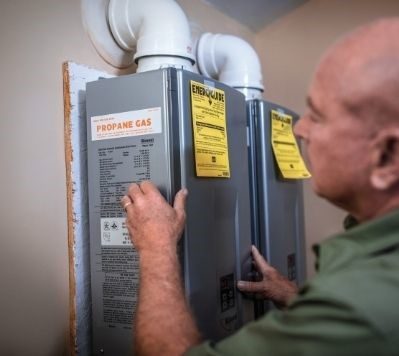Sizing Hot Water Heaters for the Home
Because of their potential for lower energy costs, tankless water heaters are becoming more popular in new homes and as replacements for storage tank units in existing ones. Propane tankless water heaters provide homeowners savings in energy costs compared with typical electric tank models. Their small footprint, ability to heat water quickly on demand, and ease of installation near the point of use are also attractive features.
Knowing how to predict hot water demand is key to meet performance and cost expectations. Professional plumbers and HVAC installers know to ask the right questions: Who will be using hot water in the home, and for what purposes? How many occupants will be in the residence? What appliances will be creating the demand for hot water and what are their delivery rates? Knowing those answers is the first step to specify a system that can meet those needs.
Installers should also know the difference between outdoor ground temperatures and the desired indoor hot water temperature, or Delta T. That will tell you how much the water will need to heat and, therefore, how quickly the unit can deliver hot water. For example, if the incoming groundwater temperature is 50 degrees and the typical showerhead delivers 2.5 gallons per minute (GPM), in most cases water should be heated to at least 120 degrees, so the home will need a tankless unit that can heat 2.5 GPM by 70 degrees. Lower flows can be heated to a bigger temperature rise and higher flows to a smaller temperature rise. Most propane tankless water heaters on the market can handle a rate of 5 GPM at a 70-degree temperature rise.
Pro Tip: As temperatures fall, more time and energy are needed to heat water to the desired level. To ensure your hot-water units meet demand throughout the entire year, it’s important to know how they’ll perform in cold weather. For example, a unit that can produce 8.5 GPM on a steamy summer day will produce only 5 to 6 GPM in the cold winter weather. Be aware of how low ground temps can go and the Delta T, as well as how much water a household will need. The bigger the gap, the lower the unit’s flow rate will be.
Peak demand scenarios are why pros shouldn’t assume an undersized system will cover their client’s full range of needs. Oversizing isn’t as big of a concern with tankless systems. While oversizing a traditional tank water heater would result in significant wasted energy over the life of the unit, tankless units vary their flow rates based on demand. Therefore, having excess capacity doesn’t necessarily mean a tankless system is using more energy.
New projects can more easily accommodate tankless units at the point of use than can existing homes, which are often designed for a central tank system and therefore may be better suited for one or more units installed in the basement. Multiple units may be used to handle larger loads or as homeowners scale up in the future as their hot water needs change.
To determine the optimal number of tankless units for a home, you must know the occupants’ consumption habits and then size a system to meet that need. Determine peak demand and gauge actual usage and lifestyle habits. Then, compare prices for systems that meet those needs relative to your client’s budget. Put in as much capacity as those factors will allow to balance cost and comfort.
The technology behind propane tankless water heaters brings many, including increased efficiency and cost savings, an endless supply of hot water and smaller, more compact units. Selecting and installing the right system will pay dividends for years to come.
Source:
